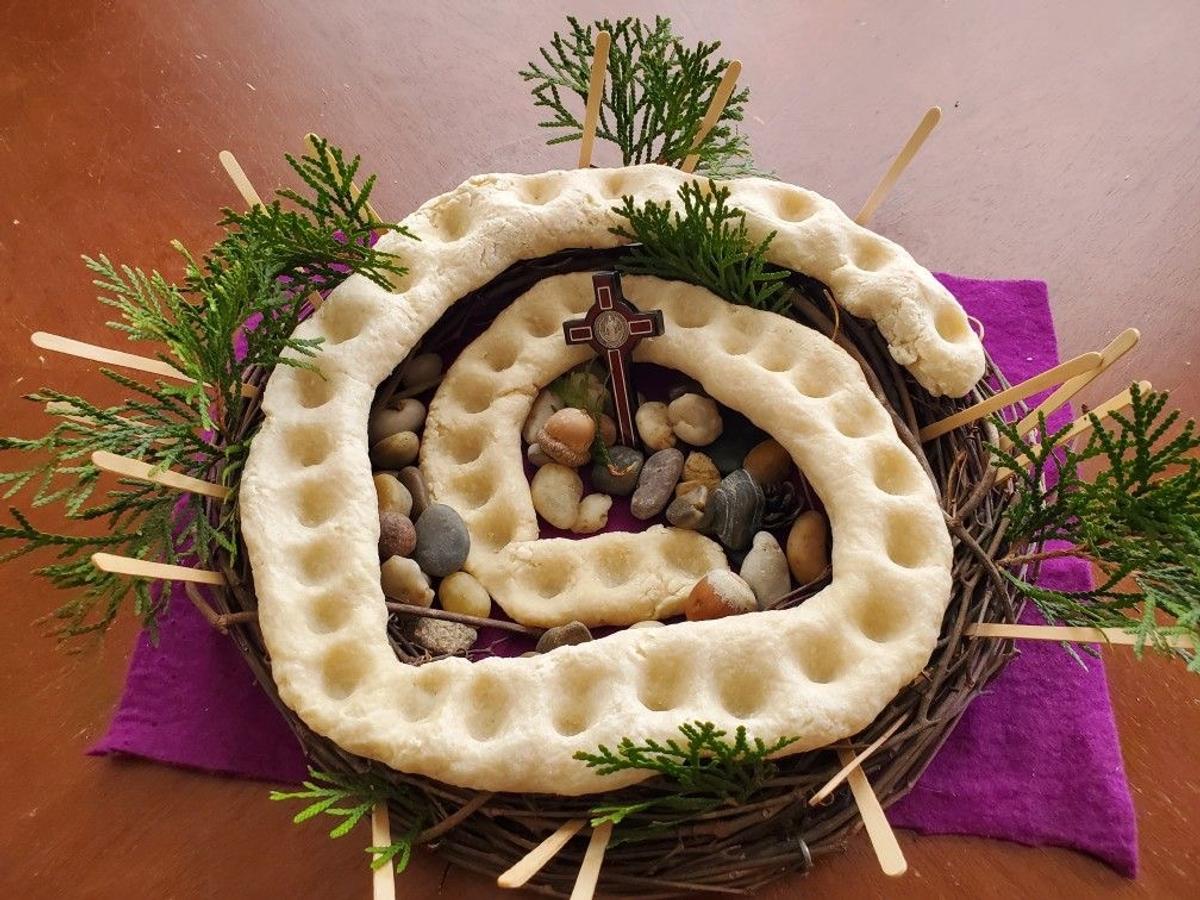Catholic Identity

LENT
As we enter the season of Lent, it’s a wonderful opportunity for our school community to reflect on the themes of sacrifice, prayer, and kindness.
Lent is the Church’s time of preparation for the Easter mystery. We remember and celebrate the crucified and risen Christ who sends the Holy Spirit. Lent is the penitential season of the Church when we are called to purify our lives from sin through prayer, fasting and almsgiving. The colour of Lent is purple, which is traditionally associated with royalty and suffering, reminding us of Christ's passion. During Lent, purple is also a symbol of penance, repentance, and renewal.
The word ‘lent’ comes from the Old English word lencten (lengthening of days). It originates in the northern hemisphere where it means ‘springtime,’ however here in the southern hemisphere Lent moves through autumn; presenting a unique symbolism for us. Nature paints a vibrant canvas of change, reminding us that letting go can be a joyful act of renewal. Trees shed their leaves to conserve energy and water during the colder months when the ground is frozen, and moisture is scarce. In this way, letting go becomes a strategy for endurance, making room for new growth in the Spring. Similarly, in this season of Lent, we are encouraged to let go of our attachments and to conserve our resources for what truly matters. In letting go of what no longer serves us, we create the space for renewal and growth; cleansing our lives by fasting, prayer and almsgiving as we prepare for the light of Christ this Easter.
In many other languages the name for the season is derived from the Latin word quadragesima for ’forty.’ The number 40 is highly significant in the Bible. Jesus fasted for 40 days in the wilderness as he prepared to proclaim the Good News. Long before the time of Jesus, Moses and Elijah had also fasted for 40 days; the great flood lasted 40 days and nights; Israel journeyed through the wilderness for 40 years. In the Bible the number 40 usually means that something very significant is happening. We often refer to Lent as a ‘journey’ of 40 days. The Lenten journey is an inner pilgrimage where we are invited to strengthen our relationship with Christ. We invite you to join us as a school community to make this Lent a time of self-reflection, gratitude, and giving.
Pope Francis on ways to fast:
Fast from hurting words and say kind words.
Fast from sadness and be filled with gratitude.
Fast from anger and be filled with patience.
Fast from pessimism and be filled with hope.
Fast from worries and have trust in God.
Fast from complaints and contemplate simplicity.
Fast from pressures and be prayerful.
Fast from bitterness and fill our hearts with joy.
Fast from selfishness and be compassionate to others.
Fast from grudges and be reconciled.
Fast from words and be silent so we can listen.
Year 3 Lent Promise Tree
Mr. Fergal Mc Geough and the Year 3s have put together this beautifully crafted Lent Promise Tree where each leaf represents a promise made by each child.
What a beautiful dispay that will serve as visual reminder for their class throughout this season of Lent.
Home Activity Idea — Lent Spiral
As we prepare for the light of Christ this Easter, think of a way you can countdown the 40 days with your family. A beautiful family tradition you can start this year is making a Lent Spiral made of salt dough with 40 indentations for the 40 days of Lent. Each day a candle can be moved one spot further in, closer to the center of the Passion narrative as we prepare for Easter. Alternatively, natural objects such as rocks or shells can be used to fill each day leading to a candle or cross in the centre. The salt dough is baked in the oven to harden and set it. It keeps well and can be used year after year. Place your Lent Spiral in an area that can be used as a prayer space for your home. I hope to make one with my son over the weekend and fill it with our beach treasures! Please share your Lent Spirals to vdelcastillo@smhampton.catholic.edu.au for us to feature in our next newsletter!
Shrove Tuesday Pancake Picnic
On Tuesday the 4th of March we were blessed with beautiful sunshine as we gathered on the school oval for a Pancake Picnic! Thank you to our Year 6 Social Justice Leaders who led us in prayer. On behalf of our school community, a big thank you to Tomasz Grabowski for his genorisity in providing us pancakes for the day! Thank you to Miss. Bianca Ludeman and Mr. Edward Simpson for supporting me in all the preperation leading to the day and to all our amazing staff for all your support in making it such an enjoyable event for all - especially to our lovely LSOs for their time in preparing the pancakes!
Thank you for your online and gold coin donations that will be going towards our mission in supporting Caritas Australia - Project Compassion help those facing poverty. We invite families to continue donating, what you are able to, throughout this season of Lent. For online donations, please use the link or scan the QR code below.
https://fundraise.projectcompassion.org.au/o/st-marys-primary-school-hampton
Ash Wednesday Liturgy
On Wednesday the 5th of March the school gathered together to mark the beginning of Lent. Thank you to Fr. Martin, Mr. Simpson, Mrs. Dolling and our Year 4s for leading our liturgy. We received ashes on our foreheads as a symbol of repentance and humility. The ashes, made from the palms of last year’s Palm Sunday, serve as a reminder of our mortality and our need for God’s grace.
Genesis 3:19 "For dust you are and to dust you shall return"
Gospel Reading - (Sunday Connection from Loyola Press)
Luke 4:1-13 The Temptation of Jesus.
In Luke's Gospel, the story of Jesus' temptation in the desert appears just after Jesus' baptism and before Jesus begins his public ministry. We can imagine this as a time of transition, a turning point in Jesus' life. Perhaps we can liken it to one of the important turning points in our own lives: the decision to marry, the birth of a child, the acceptance of a new job, or the decision to move to a new home. After the moment of decision, having reached the point of no return, we sometimes begin to wonder if we are prepared and ready for the task before us. Turning points can be times of doubt and insecurity. Jesus' response to the temptations of the devil offers an example for responding in faith when our doubts and insecurities tempt us to distrust God's sufficiency. Jesus rebukes the devil by quoting Scripture. Each citation is an affirmation of trust in God. We learn to trust in big things by practicing trust in little things. Our Lenten practices of prayer, fasting, and almsgiving invite us to trust God in these small ways. They remind us that God will suffice for us. They prepare us to trust in God in all things, especially in moments of doubt and uncertainty.
As a family, talk about ways in which trust has been built among members of the family. Observe how being trustworthy in small matters enables us to trust one another in more important matters. Offer specific examples if possible (eg. children who establish their responsibility in household tasks can be granted greater independence and freedom to choose how they perform these tasks). Today's Gospel shows us how Jesus trusted God in all things. Read aloud today's Gospel and discuss how Jesus showed his trust in God when he resisted the devil's temptations. Invite family members to name times when they have trusted God in matters small or large. Write a family prayer together. You might write the prayer so that each line begins with a letter in the word “trust.”
Wishing you warm blessings in this season of Lent,
Veronica Del Castillo
Religious Education Leader











